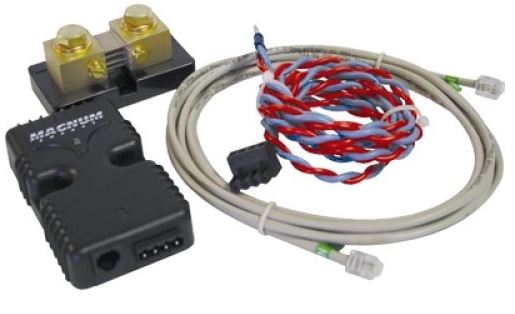| |

Magnum Battery Monitoring
Magnum Battery Monitoring Kit (BMK)
Batteries including flooded
lead acid, absorbed glass mat (AGM including VRLA valve regulated lead acid ),
and gel batteries over represent and under represent the battery's state of
charge. The term for this is termed surface charge and surface discharge.
Off-grid batteries are in constant use, therefore using voltage as an indication
of battery state is misleading. The only other three methods of than
determining battery state is by hydrometer measuring current specific gravity
or disconnecting batteries for 3 to 4 hours. Or using a battery
monitor. A Magnum Battery Monitoring Kit (BMK) works with
ME, MS, MS-AE and RD Series Inverters.
How it works:

- The BMK includes a 500 Amp
shunt, the sense module that
measures the amount of electricity passing both in and out
of the batteries.
- The red and blue
communication cable transmits the
information from the shunt to the sense module
- The sense module logs and
interprets the information .
- The gray cable (same as
telephone plug-in) communicates
the information to the inverter.
- Your system will require a
remote (either a ME-ARC ore ME-RC)
Magnum Remote Monitor
Magnum has three ME remotes;
the basic ME-RC the advanced ME-ARC. The ME-RTR, or “router” has many of the
same features as the ME-ARC50 advanced remote with the additional functionality
required to parallel Magnum MS-PAE inverter/chargers for greater output. Remotes
provide system parameter setup and performance monitoring as well as clear
indications of where a problem exists. For example, a licensed master
electrician, when he added an additional outlet made an error and created a
dead short i another room. The inverter when started would immediately
turn off. Without a monitor on the system It took hours of investigating to
identify the problem. A remote would have identify the fault failure
immediately. Who would suspect a master electrician of such a basic mistake?
There are other very useful programming options, including limiting the power
drawn from a generator so that the current draw of the system and charging
combined do not exceed the generator's capability thereby causing the
generator's breaker to trip. ...and a hundred more examples.
|